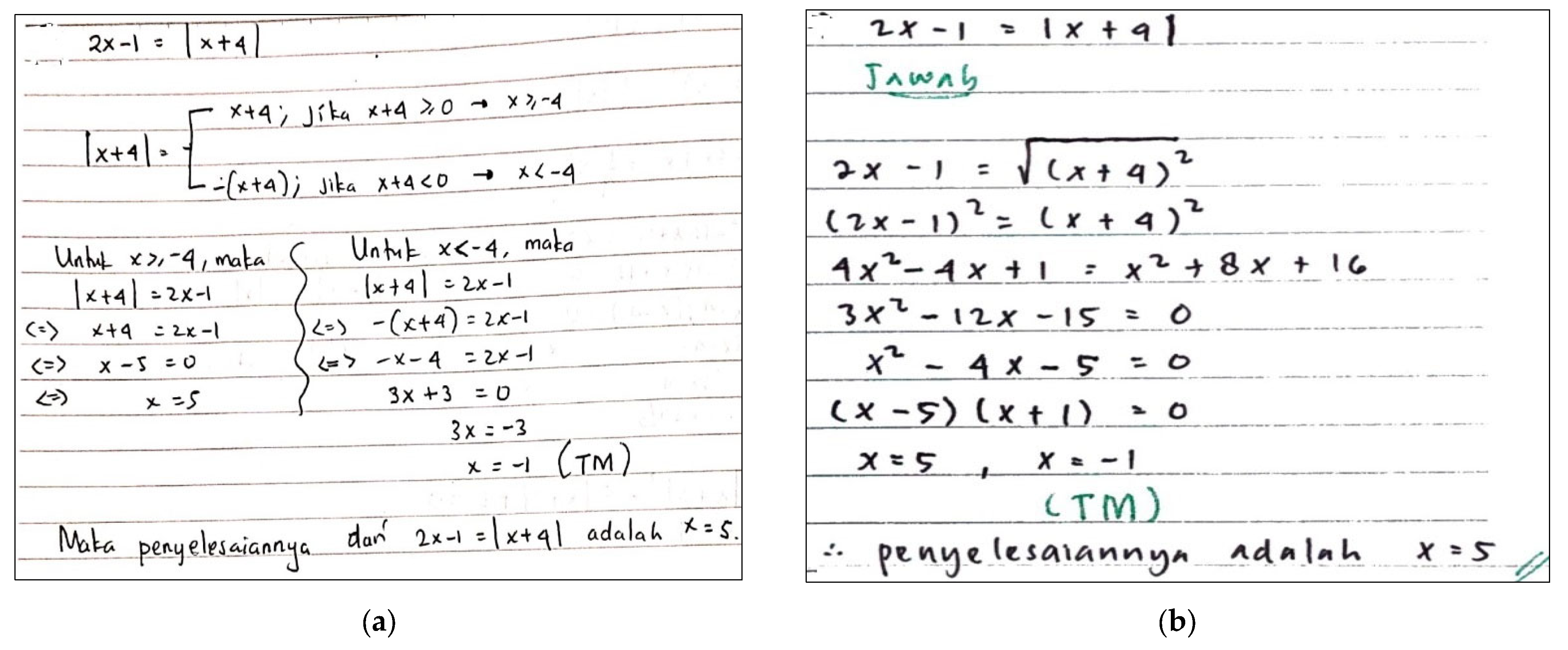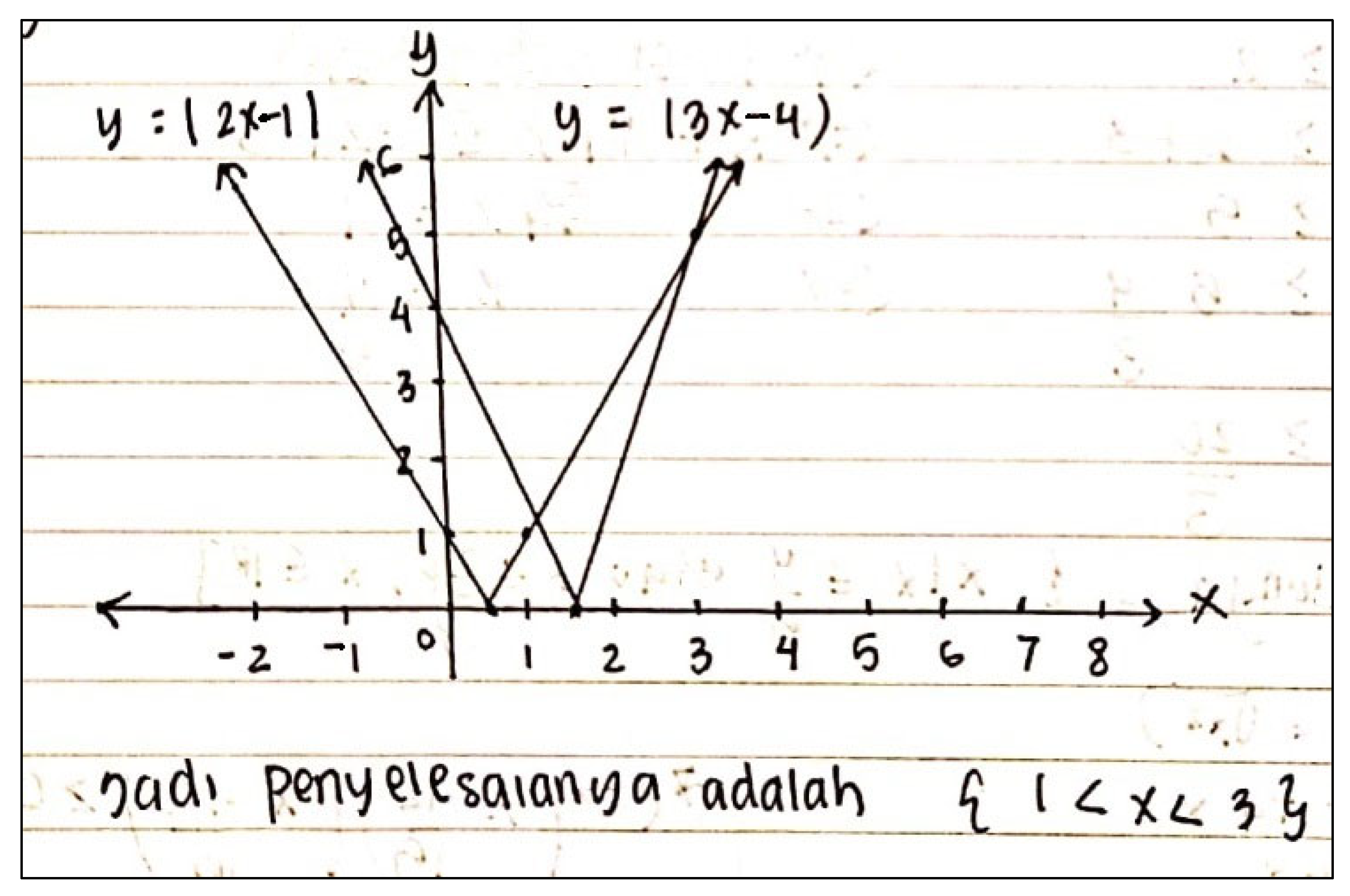Pre-Service Teachers’ Strategies in Solving Absolute Value Equations and Inequalities
Abstract
:1. Introduction
2. Materials and Methods
2.1. Participants
2.2. Data Collection
2.3. Data Analysis
3. Results
3.1. Pre-Service Teachers’ Solution Strategies in Solving Absolute Value Equations
“…as encouraged in the direction, I used the graph strategy as an additional strategy for solving absolute value equations. This strategy is visually easier to use and see. Also, it is used for checking whether solutions produced by the definition strategy or properties strategy are correct or not.”
3.2. Pre-Service Teachers’ Solution Strategies in Solving Absolute Value Inequalities
“For me, I need to consider first the absolute value inequality to solve. As using the properties strategy seems easier, I use it. If we use the definiton strategy in solving an absolute value inequality, then it would take time, and the solution process would often be lengthy. In this case, often we need to find the intersections of the interval of solutions on the number line. In my opinion, it is not efficient for using the definiton strategy.”
4. Discussion
4.1. Discussion on Absolute Value Equations
4.2. Discussion on Absolute Value Inequalities
5. Conclusions
Author Contributions
Funding
Institutional Review Board Statement
Informed Consent Statement
Data Availability Statement
Acknowledgments
Conflicts of Interest
References
- Tsamir, P.; Almog, N. Student’s strategies and difficulties: The case of algebraic inequalities. Math. Educ. Sci. Technol. 2001, 32, 513–524. [Google Scholar] [CrossRef]
- Almog, N.; Ilany, B.S. Absolute value inequalities: High school students’ solutions and misconceptions. Educ. Stud. Math. 2012, 81, 347–364. [Google Scholar] [CrossRef]
- Verikios, P.; Farmaki, V. From equation to inequality using a function-based approach. Int. J. Math. Educ. Sci. Technol. 2010, 41, 515–530. [Google Scholar] [CrossRef]
- Didis, M.G.; Erbas, A.K. Performance and difficulties of students in formulating and solving quadratic equations with one unknown. Educ. Sci. Theory Pract. 2015, 15, 1137–1150. [Google Scholar] [CrossRef] [Green Version]
- Jupri, A.; Drijvers, P.; van den Heuvel-Panhuizen, M. Student difficulties in solving equations from an operational and a structural perspective. Math. Educ. 2014, 9, 39–55. [Google Scholar] [CrossRef]
- Jupri, A.; Sispiyati, R.; Chin, K.E. An investigation of students’ algebraic proficiency from a structure sense perspective. J. Math. Educ. 2021, 12, 147–158. [Google Scholar] [CrossRef]
- Tanisli, D.; Kose, N.Y. Pre-service mathematic teachers’ knowledge of students about the algebraic concepts. Aust. J. Teach. Educ. 2013, 38, 1–18. [Google Scholar] [CrossRef] [Green Version]
- Zapatera, A.; Quevedo, E. The initial algebraic knowledge of preservice teachers. Mathematics 2021, 9, 2117. [Google Scholar] [CrossRef]
- Bicer, A.; Capraro, R.; Capraro, M. Pre-service teachers’ linear and quadratic inequalities understandings. Int. J. Math. Teach. Learn. 2014, 5, 1–10. [Google Scholar]
- Serhan, D.; Almeqdadi, F. Pre-service teachers’ linear inequalities solving strategies and errors. Glob. J. Math. 2015, 6, 580–584. [Google Scholar]
- Ozkaya, M.; Ocal, M.F.; Konyalioglu, A.C. Visualization in solving inequality questions: Case of pre-Service mathematics teachers. J. Educ. Hum. Dev. 2016, 5, 119–137. [Google Scholar] [CrossRef] [Green Version]
- Ali, C.A.; Wilmot, E.M. Pre-service teachers’ didactic conceptual structures in the absolute and quadratic inequalities. IOSR J. Math. IOSR JM 2016, 12, 62–69. [Google Scholar] [CrossRef]
- Aziz, T.A.; Supiat, S.; Soenarto, Y. Pre-service secondary mathematics teachers’ understanding of absolute value. J. Cakrawala Pendidik. 2019, 38, 203–214. [Google Scholar] [CrossRef]
- Jupri, A.; Gozali, S.M. Teaching and learning processes for prospective mathematics teachers: The case of absolute value equations. Math. Teach. Res. J. 2021, 13, 142–157. [Google Scholar]
- Bokhove, C.; Drijvers, P. Symbol sense behavior in digital activities. Learn. Math. 2010, 30, 43–49. [Google Scholar]
- Turşucu, S.; Spandaw, J.; de Vries, M.J. Search for symbol sense behavior: Students in upper secondary education solving algebraic physics problems. Res. Sci. Educ. 2020, 50, 2131–2157. [Google Scholar] [CrossRef] [Green Version]
- Arcavi, A. Symbol sense: Informal sense-making in formal mathematics. Learn. Math. 1994, 14, 24–35. [Google Scholar]
- Arcavi, A. Developing and using symbol sense in mathematics. Learn. Math. 2005, 14, 42–47. [Google Scholar]
- Jupri, A.; Sispiyati, R. Students’ algebraic proficiency from the perspective of symbol sense. Indones. J. Sci. Technol. 2020, 5, 86–94. [Google Scholar] [CrossRef]
- van Stiphout, I.; Drijvers, P.; Gravemeijer, K. The development of students’ algebraic proficiency. Int. Electron. J. Math. Educ. 2013, 8, 62–80. [Google Scholar] [CrossRef]
- Drijvers, P. Students encountering obstacles using a CAS. Int. J. Comput. Math. Learn. 2000, 5, 189–209. [Google Scholar] [CrossRef]
- Kop, P.M.; Janssen, F.J.; Drijvers, P.H.; van Driel, J.H. The relation between graphing formulas by hand and students’ symbol sense. Educ. Stud. Math. 2020, 105, 137–161. [Google Scholar] [CrossRef]
- Skemp, R.R. Relational understanding and instrumental understanding. Math. Teach. 1976, 77, 20–26. [Google Scholar]
- Dickman, B. Looking back to support problem solving. Math. Teach. 2016, 110, 54–58. [Google Scholar] [CrossRef]
- Cai, J.; Brook, M. Looking back in problem solving. Math. Teach. Inc. Micromath 2006, 196, 42–45. [Google Scholar]
- Kumari, A. Students’ difficulty with problems involving absolute value, how to tackle this using number line and box method. Math. Teach. Res. J. 2021, 13, 158–166. [Google Scholar]
- Sierpinska, A.; Bobos, G.; Pruncut, A. Teaching absolute value inequalities to mature students. Educ. Stud. Math. 2011, 78, 275–305. [Google Scholar] [CrossRef] [Green Version]
- Switzer, J.M. Graphing inequalities, connecting meaning. Math. Teach. 2014, 107, 580–584. [Google Scholar] [CrossRef]
- Kop, P.M.; Janssen, F.J.; Drijvers, P.H.; van Driel, J.H. Promoting insight into algebraic formulas through graphing by hand. Math. Think. Learn. 2021, 23, 125–144. [Google Scholar] [CrossRef]
- Florio, E. A Synergy between history of mathematics and mathematics education: A possible path from geometry to symbolic algebra. Educ. Sci. 2020, 10, 243. [Google Scholar] [CrossRef]
- Otten, M.; van den Heuvel-Panhuizen, M.; Veldhuis, M.; Boom, J.; Heinze, A. Are physical experiences with the balance model beneficial for students’ algebraic reasoning? An evaluation of two learning environments for linear equations. Educ. Sci. 2020, 10, 163. [Google Scholar] [CrossRef]
- Veith, J.M.; Bitzenbauer, P.; Girnat, B. Exploring learning difficulties in abstract algebra: The case of group theory. Educ. Sci. 2022, 12, 516. [Google Scholar] [CrossRef]
- Novotná, J.; Hoch, M. How structure sense for algebraic expressions or equations is related to structure sense for abstract algebra. Math. Educ. Res. J. 2008, 20, 93–104. [Google Scholar] [CrossRef]




| Tasks | Absolute Value Equations | |
|---|---|---|
| 1. | An absolute value equation consisting of a linear form within an absolute value sign on one side and a constant term on another side of the equation | |
| 2. | An absolute value equation with linear forms within absolute value signs on both sides of the equation | |
| 3. | An absolute value equation with a linear form within an absolute value sign on one side and a linear form on the other side of the equation | |
| 4. | An absolute value equation using a quadratic equation structure | |
| Tasks | Absolute Value Inequalities | |
|---|---|---|
| 5. | An absolute value inequality consisting of a linear form within an absolute value sign on one side and a constant term on another side of the inequality | |
| 6. | An absolute value inequality with linear forms within absolute value signs on both sides of the inequality | |
| 7. | An absolute value inequality with a linear form within an absolute value sign on one side and a linear form on the other side of the inequality | |
| 8. | An absolute value inequality consisting of a rational form within an absolute value sign on one side and a constant term on another side of the inequality | |
| Task | Absolute Value Equations | #Correct Solution (%) | Solution Strategies | ||
|---|---|---|---|---|---|
| #Definition Strategy (%) | #Properties Strategy (%) | #Graph Strategy (%) | |||
| 1. | 34 (94.4) | 34 (94.4) | 12 (33.3) | 7 (19.4) | |
| 2. | 34 (94.4) | 11 (30.5) | 26 (72.2) | 10 (27.7) | |
| 3. | 27 (75.0) | 20 (55.5) | 18 (50.0) | 7 (19.4) | |
| 4. | 33 (91.7) | 23 (63.8) | 15 (41.7) | 5 (13.8) | |
| Task | Absolute Value Inequalities | #Correct Solution (%) | Solution Strategies | ||
|---|---|---|---|---|---|
| #Definition Strategy (%) | #Properties Strategy (%) | #Graph Strategy (%) | |||
| 5. | 34 (94.4) | 18 (50.0) | 36 (100.0) | 1 (2.7) | |
| 6. | 33 (91.7) | 3 (8.3) | 36 (100.0) | 9 (25.0) | |
| 7. | 34 (94.4) | 24 (66.7) | 24 (66.7) | 1 (2.7) | |
| 8. | 31 (86.1) | 4 (11.1) | 32 (88.8) | 7 (19.4) | |
Publisher’s Note: MDPI stays neutral with regard to jurisdictional claims in published maps and institutional affiliations. |
© 2022 by the authors. Licensee MDPI, Basel, Switzerland. This article is an open access article distributed under the terms and conditions of the Creative Commons Attribution (CC BY) license (https://creativecommons.org/licenses/by/4.0/).
Share and Cite
Jupri, A.; Usdiyana, D.; Gozali, S.M. Pre-Service Teachers’ Strategies in Solving Absolute Value Equations and Inequalities. Educ. Sci. 2022, 12, 743. https://doi.org/10.3390/educsci12110743
Jupri A, Usdiyana D, Gozali SM. Pre-Service Teachers’ Strategies in Solving Absolute Value Equations and Inequalities. Education Sciences. 2022; 12(11):743. https://doi.org/10.3390/educsci12110743
Chicago/Turabian StyleJupri, Al, Dian Usdiyana, and Sumanang Muhtar Gozali. 2022. "Pre-Service Teachers’ Strategies in Solving Absolute Value Equations and Inequalities" Education Sciences 12, no. 11: 743. https://doi.org/10.3390/educsci12110743






